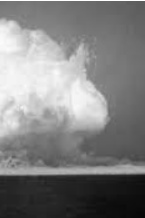
J. Robert Oppenheimer and the other members of the Manhattan Project knew very little about the behaviour of their brand-new atomic bomb when they prepared to test it in the deserts of New Mexico in July 1945. The plutonium-implosion device was used in a test on July 16 that was code-named “Trinity” . And the explosion that followed was significantly more powerful than expected. The irradiated mushroom cloud also rose far higher than anticipated, between 50,000 and 70,000 feet. Nobody knew where it would ultimately end up. A recent analysis, which was made public on Thursday before being submitted for peer review to a scientific journal. Demonstrates that the cloud and its fallout travelled further than anyone in the Manhattan Project had anticipated in 1945.
The authors of the study claim that within 10 days of detonation, radioactive fallout from the Trinity test reached 46 states, Canada. And Mexico using cutting-edge modelling software and freshly discovered historical weather data.The study’s lead author, Sébastien Philippe, a researcher and scientist at Princeton University’s Programme on Science. And Global Security, stated, “It’s a huge finding but.At the same time, it shouldn’t surprise anyone. ”The team also plans to research US testing over the Pacific Ocean in the future. The study also reanalyzed fallout from all 93 aboveground US nuclear tests in Nevada. And produced a map showing the composite deposition of radioactive particles throughout the entire US.It is challenging to estimate how much of Trinity’s fallout is still present at initial deposition locations around the nation. According to Susan Alzner, a study author and co-founder of shift7, a company that organised the study’s research.
The study describes deposition as it first emerged in 1945. It’s like a snapshot of time, she remarked.Advocates hoping to increase the number of persons qualified for federal government compensation for potential radiation exposure from atmospheric nuclear explosions may use the data as evidence.
Manhattan Project physicists and medical professionals tracked the Trinity cloud’s drift. But mistakenly overestimated its range.”They were aware that there were radioactive hazards. But they were thinking about acute risk in the areas around the immediate detonation site,” said Alex Wellerstein, a nuclear historian at Stevens Institute of Technology in New Jersey. He claimed that they knew very little about how radioactive materials could become embedded in local and remote ecosystems. They did not give any thought to the fallout problem, which is the impact of low dosages on big populations.Assessments. And endeavours to study the effects of the Trinity exam were hindered in the decades that followed by the absence of essential data.
According to Philippe, there were no national monitoring stations set up in the US in 1945 to keep track of the fallout. Furthermore, the crucial historical meteorological and atmospheric data was only accessible after 1948. Remodelling the consequences from Nevada tests, which began in 1951, became simpler. But reanalyzing Trinity remained exasperatingly challenging.According to Alzner. “The data sets for the Nevada tests and the data we might have been able to find for Trinity were not comparable.” They could not be located on the same map. We made the decision to press forward.
The researchers began the investigation around 18 months ago, eager to close any gaps. Philippe has a wealth of experience in modelling fallout and was a contributor to a research. That examined the consequences of French nuclear testing in 2021. In March, a breakthrough occurred when Alzner and Megan Smith. Another shift7 co-founder and a former U.S. chief technology officer in the Obama administration, got in touch with NOAA. The team inform there by Gilbert P. Compo, a senior research scientist at the University of Colorado and the NOAA Physical Sciences Laboratory. That the European Centre for Medium-Range Weather Forecasts had just one week earlier published historical data. That depicted weather patterns extending 30,000 feet or higher above the surface of the Earth.
”For the first time, we had the most accurate hourly reconstruction of the weather back to 1940. Around the world,” said Compo, who joined the study as a co-author. “Every single event, no matter what it is, that puts something in the air. Can now be tracked, by the hour.”Philippe then conduct a new analysis of Trinity’s fallout using the update data and NOAA-built software. Although the study’s authors recognise that their calculations have several flaws and uncertainties. They nonetheless insist that “our estimates likely remain conservatively low.”
FOLLOW US ON INSTAGRAM: BIZEMAG
